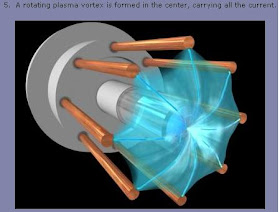The technology takeoff point for nuclear fusion should hit by 2015 and there is even a chance for signicant proof before the end of 2011. Also, once a few prove viable then the other approachess could also be more fundable and be adapted to be made viable. One of the biggest argument against all of them is Bremsstrahlung radiation, which is too much energy leaking away via microwaves. Once a few show how to overcome the problem then all of them can get tweaked if they would not already work
_BrianWang
Brian Wang provides perhaps the best coverage of nuclear fusion developments on the web.
In his latest fusion posting, Brian looks at several competing small fusion projects, complete with images and links.
Besides front-runners Focus Fusion, EMC2, and General Fusion, Brian looks at Tri-alpha Energy, Helion Energy, Japan Muon fusion, "impact fusion", Cold Fusion, and nuclear fusion for space propulsion. Excerpt:
Recent work suggests that impact fusion is more viable than previously believed.You may want to bookmark the link to Brian's nuclear fusion category, so you can keep up on the latest.
It looks promising but I guess it is at least 5 years away from a full scale test and more likely ten+ years. Unless one of the current linear colliders could be adapted.
The researchers are from China, so this could be attempted by China. I also see this work being helped with the improvement and lowering of costs for superconducting magnets. Higher Tesla field strengths. Iron superconductors might reach 200 tesla. There is a project to build 32 tesla superconducting magnet with YCBO variant wire. 2015 should see the Superpower Inc ramping up of 2G wire production payoff with far lower costs. Far more powerful and affordable superconducting magnets makes most of the nuclear fusion designs smaller and better to implement.
There is the possibility of a breakthrough with Low energy nuclear reactions (what was called cold fusion). I like the nickel 64 - stripping reactions theory.
The potential of a viable implementation of nickel-64 stripping reactions.
All of the nuclear fusion approaches have the potential to enable hybrid fusion-fission to close the fission fuel cycle (virtually no nuclear waste) even if they fall short of pure commercial fusion.

No comments:
Post a Comment